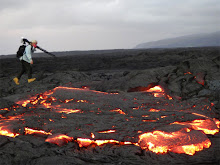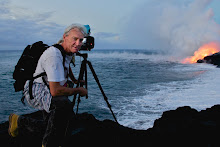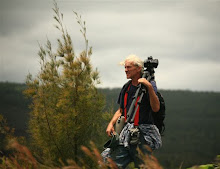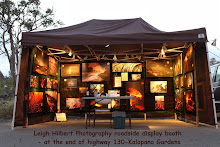 More field lava photos and descriptive captions can be seen on the USGS link above.
More field lava photos and descriptive captions can be seen on the USGS link above.(Click on the images to open a larger view window)
 The photo above is a closer look at the lava breakouts high on the pali edge just above the old Royal Gardens subdivision as seen along the viewing area roadway at 10:00 PM last night with a 200mm lens.
The photo above is a closer look at the lava breakouts high on the pali edge just above the old Royal Gardens subdivision as seen along the viewing area roadway at 10:00 PM last night with a 200mm lens.Deflation/Inflation, or DI events of the Kilauea magma chambers are being recorded by USGS/HVO crater monitors and have displayed some pronounced swings this past week. Currently the graphs are showing some deeper deflation, which may temporarily slow the advancement of pali lava by reducing lava pressures within the eruption zones:

There are no active lava breakouts on coastal flats and no ocean entry lava at this time.
I will update these blog postings next when there are some significant changes or newsworthy reports to offer you :)
Active lava viewing prospects for the public:
1) The Halema’uma’u crater has been degassing sulfur dioxide fumes by day and glowing strongly at times after dark from lava deep within the craters pit vent. The broiling molten lava moves up and down inside this massive eruptive vent by hundreds of feet at times, in kind of a pistoning action. This raising and lowering of lava has the potential to breach the floor of the crater and likely will do so in the future. Great views of this impressive crater are from the Jaggar Museum balcony within the Hawaii Volcanoes National Park, depending on the weather; and the park is open to the public 24 hours a day with a nominal entrance fee by day..
2) Coastal viewing: Three to four hundred visitors seeking to witness lava activity have been arriving daily at the Hawaii County Kalapana viewing area: The viewing area is essentially the last mile of paved road on highway 130; the end of which is the same location where lava came onto the highway on May 5th, 2010. A walk down the road gives views of the lava fuming/degassing where it is coming down the distant pali during the day. After dark lava glow can possibly be seen in two or three places high atop the mountain slopes, which is becoming a little brighter each night as it works further down the mountain towards the coastal flats and highway 130..
Official viewing hours are from 2:00 PM until around 9/9:30 PM - everyday, with last car allowed in at 8:00 PM. On site are security personnel and a few port-o-potties at both the parking lot and at the end of the road. Vendors occasionally have drinking water and flashlights but it is best to bring both these things with you and also some decent walking shoes. This end of highway 130 is open to all traffic on all other hours.










No comments:
Post a Comment